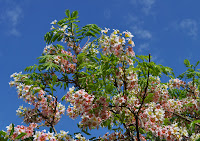For the last two nights (May 9th and 10th), if anyone had asked me, “How’s your garden,” I would have answered, “I’ve got everything covered.” Literally.
Temperatures were predicted to drop to or below freezing and I had to protect two beds each of tomato transplants and blossoming strawberries. Strawberries always blossom while there’s still chance of frost so, just like every year, I threw old sheets and blankets over the beds. As for the tomatoes: A few days of warm weather the previous week had made me jump the gun on the tomatoes, planting them out almost two weeks earlier than usual. So much for being the rational gardener.

But, as I said, I got them covered. Literally. I was not so irrational as to not plan ahead, and
right after planting I installed the same “tunnels” over the tomato row that protected endive and lettuce from cold late last autumn. The setup consists of wire hoops about five feet apart over which I drape floating row cover; clear plastic goes over the row cover, followed by another wire hoop over each of the lower ones. The upper hoops sandwich the row cover and clear plastic to keep them in place and allow me to slide them up for venting in sunny weather then down on chilly nights.
Most dramatic, though, and really getting things covered, is the heavy cloth that I draped temporarily over each tunnel. That cloth happens to be bright orange, leaving two eye-catching strips in the garden.
The nighttime lows dropped to 30 and 28 degrees. This morning I drew back the orange covers, slid up the plastic cover for ventilation on this sunny day, and peeked beneath the layer of row cover, which will remain in place to provide some extra warmth. The tomatoes looked fine.
---------------------------------------------------------
And the winner for this year’s best worst weed will be, based on early performance . . . (drumroll) . . . hedge bindweed. It’s popping up out of the ground all over the place, at least in my yard. Well, not everywhere. It is wise enough to stay out of the vegetable beds, where it would not stand a chance against me, preferring, instead, the leaf or wood chip mulched ground beneath fruit trees and bushes.
Perhaps hedge bindweed is also making a grand appearance in your garden. Look for emerging vines that are so eager to grab hold of and twist around anything that neighboring sprouts work themselves airborne by twisting around each other for support. The plants are mostly vine at this point; what leaves unfold are shaped like arrowheads and 3 or 4 inches long.
Summer is when the plant is most obvious, even admired, and that’s for its funnel-shaped, white or pink flowers. They are very pretty and look like morning glories, just a little smaller. That resemblance is well-founded, because hedge bindweed is a close relative of morning glory.
Unfortunately, hedge bindweed parts ways with morning glory in being a perennial vine that spreads both by seeds and by fleshy rhizomes. A rhizome is an underground stem that can sprout to make a whole new plant, which is what happens when you chop up the ground trying to get rid of hedge bindweed.
My tack in controlling hedge bindweed is diligence: I keep an eye out for the young sprouts and whenever I see one I reach down and pull it out. Removing the greenery will eventually starve out the roots. This method worked well about 10 years ago, the last time some confluence of the previous growing season’s weather, winter weather, and who knows what else made hedge bindweed that year’s best worst weed.
-----------------------------------------------------------

Bamboo shoots are sprouting, even escaping beyond their allotted boundary, which is a heavy duty plastic barrier sunk 2 feet into the ground. Each shoot grows 6 inches a day in warm weather, something that they’ll do for the next month or so, until they reach a height of about 15 feet. Mostly, this rapid growth gladdens me, letting my bamboo patch fill in again after my drastic pruning of a couple of years ago. The escapees are a little frightening.
The smaller sprouts can be dealt with by being cut down, dug up, or just given a sharp kick, but the fatter sprouts . . . hmm . . . bamboo sprouts, bamboo shoots. Those sprouts must be edible. Peeling the papery sheath enclosing the sprout, then cutting off the tough lower portion as well as the tip portion, which consists of only layers of those papery sheaths, leaves a tender bright green shoot. Sliced into inch-long lengths, then steamed for a few minutes, the sprouts were tender with a distinctive taste that is good alone or mixed with asparagus, kale, Good King Henry, and other pickings from the spring garden.






